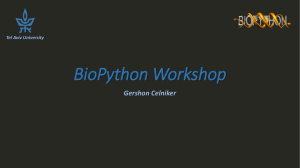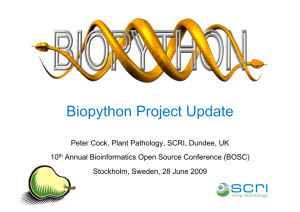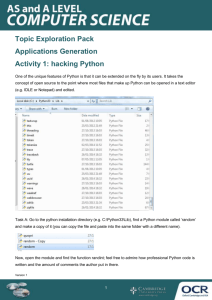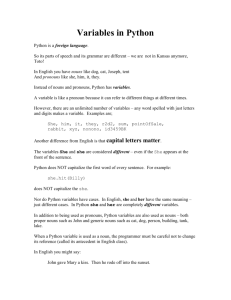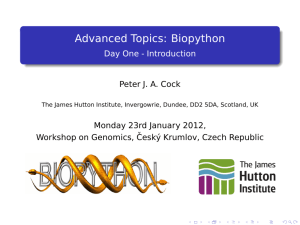ACMbiopy
advertisement
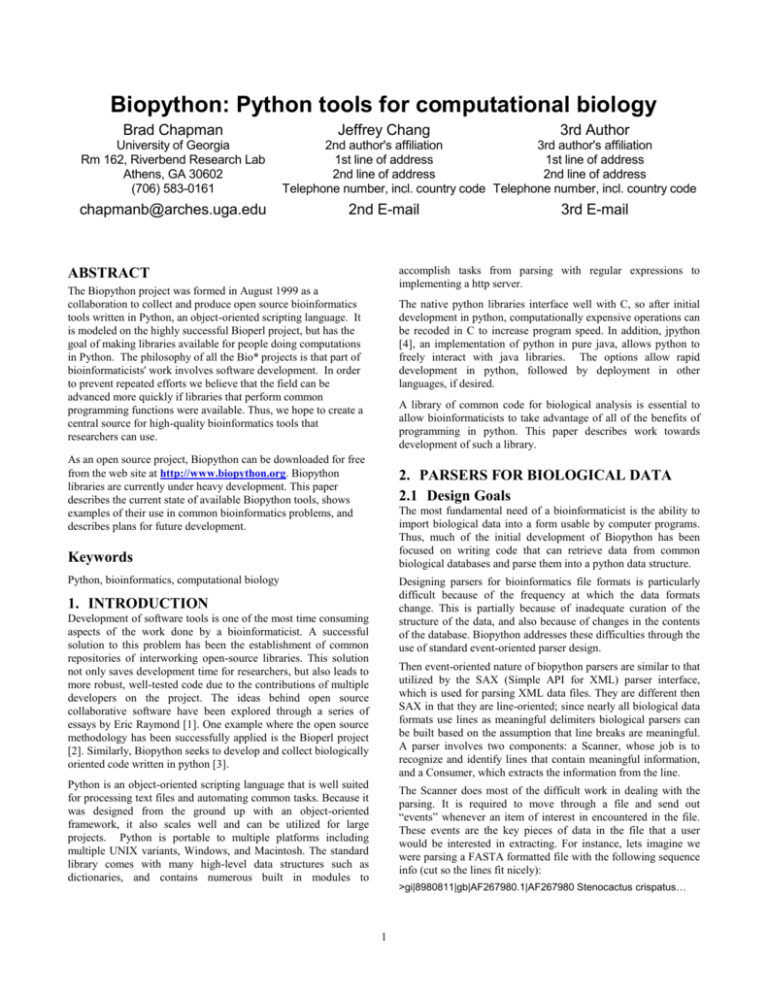
Biopython: Python tools for computational biology
Brad Chapman
University of Georgia
Rm 162, Riverbend Research Lab
Athens, GA 30602
(706) 583-0161
chapmanb@arches.uga.edu
Jeffrey Chang
3rd Author
2nd author's affiliation
3rd author's affiliation
1st line of address
1st line of address
2nd line of address
2nd line of address
Telephone number, incl. country code Telephone number, incl. country code
2nd E-mail
3rd E-mail
accomplish tasks from parsing with regular expressions to
implementing a http server.
ABSTRACT
The Biopython project was formed in August 1999 as a
collaboration to collect and produce open source bioinformatics
tools written in Python, an object-oriented scripting language. It
is modeled on the highly successful Bioperl project, but has the
goal of making libraries available for people doing computations
in Python. The philosophy of all the Bio* projects is that part of
bioinformaticists' work involves software development. In order
to prevent repeated efforts we believe that the field can be
advanced more quickly if libraries that perform common
programming functions were available. Thus, we hope to create a
central source for high-quality bioinformatics tools that
researchers can use.
The native python libraries interface well with C, so after initial
development in python, computationally expensive operations can
be recoded in C to increase program speed. In addition, jpython
[4], an implementation of python in pure java, allows python to
freely interact with java libraries. The options allow rapid
development in python, followed by deployment in other
languages, if desired.
A library of common code for biological analysis is essential to
allow bioinformaticists to take advantage of all of the benefits of
programming in python. This paper describes work towards
development of such a library.
As an open source project, Biopython can be downloaded for free
from the web site at http://www.biopython.org. Biopython
libraries are currently under heavy development. This paper
describes the current state of available Biopython tools, shows
examples of their use in common bioinformatics problems, and
describes plans for future development.
2. PARSERS FOR BIOLOGICAL DATA
2.1 Design Goals
The most fundamental need of a bioinformaticist is the ability to
import biological data into a form usable by computer programs.
Thus, much of the initial development of Biopython has been
focused on writing code that can retrieve data from common
biological databases and parse them into a python data structure.
Keywords
Python, bioinformatics, computational biology
Designing parsers for bioinformatics file formats is particularly
difficult because of the frequency at which the data formats
change. This is partially because of inadequate curation of the
structure of the data, and also because of changes in the contents
of the database. Biopython addresses these difficulties through the
use of standard event-oriented parser design.
1. INTRODUCTION
Development of software tools is one of the most time consuming
aspects of the work done by a bioinformaticist. A successful
solution to this problem has been the establishment of common
repositories of interworking open-source libraries. This solution
not only saves development time for researchers, but also leads to
more robust, well-tested code due to the contributions of multiple
developers on the project. The ideas behind open source
collaborative software have been explored through a series of
essays by Eric Raymond [1]. One example where the open source
methodology has been successfully applied is the Bioperl project
[2]. Similarly, Biopython seeks to develop and collect biologically
oriented code written in python [3].
Then event-oriented nature of biopython parsers are similar to that
utilized by the SAX (Simple API for XML) parser interface,
which is used for parsing XML data files. They are different then
SAX in that they are line-oriented; since nearly all biological data
formats use lines as meaningful delimiters biological parsers can
be built based on the assumption that line breaks are meaningful.
A parser involves two components: a Scanner, whose job is to
recognize and identify lines that contain meaningful information,
and a Consumer, which extracts the information from the line.
Python is an object-oriented scripting language that is well suited
for processing text files and automating common tasks. Because it
was designed from the ground up with an object-oriented
framework, it also scales well and can be utilized for large
projects. Python is portable to multiple platforms including
multiple UNIX variants, Windows, and Macintosh. The standard
library comes with many high-level data structures such as
dictionaries, and contains numerous built in modules to
The Scanner does most of the difficult work in dealing with the
parsing. It is required to move through a file and send out
“events” whenever an item of interest in encountered in the file.
These events are the key pieces of data in the file that a user
would be interested in extracting. For instance, lets imagine we
were parsing a FASTA formatted file with the following sequence
info (cut so the lines fit nicely):
>gi|8980811|gb|AF267980.1|AF267980 Stenocactus crispatus…
1
AAAGAAAAATATACATTAAAAGAAGGGGATGCGGG…
def title(self, line):
# see if the title contains a reference to humans
location = string.find(line, "Homo sapiens")
if location != -1:
# split the string to give us the accession number
result = string.split(line, '|')
print 'Accession:', result[3]
As the scanner moved through this file, it would fire off 4
different types of events. Upon reaching a new sequence a
‘begin_sequence’ event would be sent. This would be followed by
a ‘title’ event upon reaching the information about the sequence
and a ‘sequence’ event for every line of sequence information.
Finally, everything would wrap up with an ‘end_sequence’ when
we have no more sequence data in the entry.
The Consumer inherits from a base consumer class which ignores
any sections that we are not interested in (like sequences). Now
that we've got a consumer, we need to start up a scanner, inform it
of what consumer we want to send events to, and then parse the
file. The following code accomplishes this:
Creating and emanating these events is interesting, but is not very
useful unless we get some kind of information from the events,
which is where the Consumer component comes in. The consumer
will register itself with a scanner and let it know that it wants to
know about all events that occur while scanning through a file.
Then, it will implement functions which deal with the events that
it is interested in.
# set up the scanner, consumer and file to parse
from Bio.Fasta import Fasta
scanner = Fasta._Scanner()
consumer = TitleSearchConsumer()
file = open('taxol.fasta', 'r')
To go back to our FASTA example, a consumer might just be
interested in counting the number of sequences in a file. So, it
would implement a function ‘begin_sequence’ that increments a
counter by one every time that event occurs. By simple receiving
the information it is interested in from the Scanner, the consumer
processes and deals with the files according to the programmer’s
needs.
# parse all fasta records in the file
for n in range(22):
scanner.feed(file, handler)
Running this example gives the following output:
By decoupling scanners from consumers, developers can choose
different consumers depending on their information or
performance needs, while maintaining the same scanner. It is
possible to develop multiple specialized consumer-handlers using
the same scanner framework. These parsers can deal with a small
subsection of the data relatively easily. For example, it may be
desirable to have a parser that only extracts the sequence
information from a Genbank file, without having to worry about
the rest of the information. This would save time by not
processing unnecessary information, and save memory by not
storing it.
$ python fasta_ex.py
Accession: AW615564.1
Accession: NM_004909.1
Accession: AF157562
…
This example uses the raw scanner-consumer interface we
described above. Doing this can be clunky in many ways, since
we have to explicitly know how many records we have to parse,
and also need to access the scanner, which is marked as an
internal class. The reason for this is that there are layers developed
on top of the raw scanner and consumer classes which help make
them more intuitive to use.
2.2 Usage Examples
2.2.1 Usage Scenario
To take a look at the parsers in action, we'll look at some
examples based around a common theme, to make things a little
more exciting. Let's suddenly become really interested in Taxol, a
novel anti-cancer drug [5] and use this newfound interest to frame
our work.
2.2.3 Parsing Output from Swiss-Prot
Delving further into taxol we next decide to look for further
information in Swiss-Prot [7], a hand curated database of protein
sequences. We search for Taxol or Taxus (Taxol was first isolated
from the bark of the pacific yew, Taxus brevifolia). This yields 15
results, which we save in SwissProt format. Next, we would like
to print out a description of each of the proteins found. To do this,
we use an iterator to step through each entry, and then use the
SwissProt parser to parse each entry into a record containing all of
the information in the entry.
First, we set up a parser and an iterator to use:
2.2.2 Extracting information from a FASTA file
To start our search for Taxol information, we first head to NCBI
to do an Entrez search over the Genbank nucleotide databases [6].
Just searching for the keyword 'taxol' gives 22 results, so let's say
we want to parse through these results and extract id numbers
from those that have to do with humans. To do this, we save the
search results as a FASTA file, and then proceed to parse this.
Based on the scanner-consumer discussion above, what we need
to do is implement a consumer which will react every time we
reach a title in the FASTA file, and check to see if the title
mentions anything to do with humans. The following consumer
does this job:
from Bio.SwissProt import SProt
file = open('taxol.swiss', 'r')
parser = SProt.RecordParser()
my_iterator = SProt.Iterator(file, parser)
The parser is a RecordParser which converts a SwissProt entry
into the record class mentioned above. Now, we can readily step
through the file record by record, and print out just the
descriptions from the record class:
import string
from Bio.ParserSupport import AbstractConsumer
class TitleSearchConsumer(AbstractConsumer):
2
next_record = my_iterator.next()
In sum, these examples demonstrate how the Biopython classes
can be used to automate common biological tasks and deal with
bioinformatic data in a pythonic manner.
while next_record:
print 'Description:', next_record.description
next_record = my_iterator.next()
3. REPRESENTING SEQUENCES
3.1 Design Goals
Utilizing the iterator and record class interfaces, the code ends up
being shorter and more understandable. In many cases this
approach will be enough to extract the information you want,
while the more general Scanner and Consumer classes are always
available if you need more control over how you deal with the
data.
Sequences of biological data are ubiquitous in bioinformatics, so
it is essential to develop a standard sequence representation. The
most natural way to think of sequences is as strings of characters,
since this is the most common way they are encountered.
Although this is an intuitive representation, it also very limiting,
since sequences themselves have additional properties. In
addition, many sequences, such as entire genomes, may be too
large to fit into memory at the same time. Therefore, a critical
challenge is designing the sequence interface which makes
dealing with Biopython sequences as easy as dealing with strings,
but which also allows the sequences to take on additional
properties.
2.2.4 Downloading and Extracting information from
Pub-Med
Finally, in our search for Taxol information, we would like to
search PubMed [8] and get Medline articles dealing with Taxol.
Biopython provides many nice interfaces for doing just this.
First, we would like to do a PubMed search to get a listing of all
articles having to do with Taxol. We can do this with the
following two lines of code:
Biopython represents sequences as a lightweight sequence class
that utilizes the object oriented nature of python and makes
generous use of operator overloading. This combination allows
sequences to be easily manipulated using common string
operations, while also allowing sequence objects to be directly
used in more complex operations. The examples below
demonstrate the utility of this approach.
from Bio.Medline import PubMed
taxol_ids = PubMed.search_for('taxol')
Of course, article ids are not much use unless we can get the
Medline records. Here, we create a dictionary that can retrieve a
PubMed entry by its id, and use a Medline parser to parse the
entry into a usable format. A PubMed dictionary is accessible
using python dictionary semantics, in which the keys are PubMed
ids, and the values are the records in Medlars format.
3.2 Usage Examples
The sequence class has two important attributes: its string
representation, and an Alphabet class describing the allowable
characters in the sequence. The representations we will use here
are from the IUPAC nomenclature [9]. The two major advantages
of this approach are that it assigns some rigidity and automatic
error checking to your analysis, and that it allows the identity and
characteristics of a sequence to be examined.
You can create a sequence object very simply:
my_parser = Medline.RecordParser()
medline_dict = PubMed.Dictionary(parser = my_parser)
Now that we've got what we need, we can walk through and get
the information we require:
for id in taxol_ids[0:5]:
this_record = medline_dict[id]
print 'Title:', this_record.title
print 'Authors:', this_record.authors
>>> from Bio.Seq import Seq
>>> from Bio.Alphabet import IUPAC
>>> my_seq = Seq('GCGATGCTATG', IUPAC.unambiguous_dna)
The my_seq object is a "Seq" object, and not just a string:
Running this code will give output like the following:
$ python medline_ex.py
Title: PKC412--a protein kinase inhibitor with a broad therapeutic
potential
[In Process Citation]
>>> print my_seq
Seq('GCGATGCTATG', IUPACUnambiguousDNA())
However, the string can be easily obtained as an attribute of the
my_seq object:
Authors: ['Fabbro D', 'Ruetz S', 'Bodis S', 'Pruschy M', 'Csermak K',
'Man A', 'Campochiaro P', 'Wood J', "O'Reilly T", 'Meyer T']
….
>>> print my_seq.data
GCGATGCTATG
In this example, the Biopython classes make it easy to get
PubMed information in a format that can be easily manipulated
using standard python tools. For instance, the authors are
generated in a python list, so they could easily be searched with
code like:
Additionally, you can perform common string operations like
getting the length or obtaining a slice directly on the sequence
object:
>>> print len(my_seq)
11
>>> print my_seq[3:6]
Seq('ATG', IUPACUnambiguousDNA())
>>> my_seq2 = Seq('ATATATA', IUPAC.unambiguous_dna)
>>> print my_seq + my_seq2
Seq('GCGATGCTATGATATATA', IUPACUnambiguousDNA())
If ‘Monty P’ in authors:
print ‘found author Monty P’
3
Note that despite the fact that you are performing string
operations on the sequence object, the return values are still Seq
objects whose attributes, such as alphabet, are preserved.
4.2 Classification Tools
Biopython also contains tools which implement common
classification (supervised machine learning) algorithms, which are
generally usable for any task which involves separating data into
distinct groups. Currently, these type of algorithms are widely
applied in analysis of microarray data, where researchers often
want to separate genes into distinct groups based on their
expression patterns. Currently, three different supervised
classification algorithms are implemented in Biopython: Support
Vector Machines, Naive Bayes, and k-Nearer-Neighbors. These
tools are designed to be easy to get started with and contain 'train'
functions which allow you to utilize default training algorithms in
a quick analysis. However, they also contain interfaces for
implementing custom training functions, so they are usable by
advanced users.
Although you can deal with sequences simply in this manner, we
can also do more complex operations directly on these objects.
For instance, you can readily transcribe the DNA sequence into
the corresponding RNA sequence:
>>> from Bio.Tools import Transcribe
>>> my_transcriber = Transcribe.unambiguous_transcriber
>>> print my_transcriber.transcribe(my_seq)
Seq('GCGAUGCUAUG', IUPACUnambiguousRNA())
Similarly, we can do translations using a number of different
codon tables. Here, we will use the standard codon table to do the
translation of our small sequence:
4.3 Additional Functionality
>>> from Bio.Tools import Translate
>>> my_translator =
Translate.unambiguous_dna_by_name['SGC0’]
>>> print my_translator.translate(my_seq)
Seq('AML', IUPACProtein())
In addition to all of the modules mentioned here, Biopython also
contains parsers for dealing with data generated from BLAST
[12], Enzyme [13], Prosite [14], and SCOP [15]. Additionally,
code exists for directly accessing popular bioinformatics web
services, allowing access to these services directly from python
scripts.
Hopefully, these examples give a taste for the way you can
interact with sequences through Biopython, and show the utility
of this approach.
5. Future Goals
As mentioned, Biopython is still under heavy development, and
has many exciting upcoming plans. In a true open-source nature,
the code is always available for scrutiny in publicly accessible
CVS archives, and discussions occur regularly on several list
serves.
4. Other Tools
4.1 Biocorba interface
Because each programming language has its own advantages and
disadvantages, one important goal is to achieve a degree of
interoperability between libraries in different languages. A natural
choice for helping to achieve this goal is the Common Object
Request Broker Architecture (CORBA) [10], a set of
specifications which allows code written in different languages to
interoperate freely, even for programs running on different
machines.
5.1 Planned Features
Biopython has numerous projects which are planned for the
future., including:
Taking advantage of CORBA, the Bioperl, Biojava and Biopython
projects collaborated to develop an interface description allowing
the projects to inter-communicate. Written in the interface
definition language (IDL) of CORBA, it defines sequences with
features, as well as methods to operate on those features.
Biopython has developed a module referred to as biopythoncorba, which allows biopython to communicate with
implementations of the biocorba interface written in perl and java.
This allows python programmers to take advantage of code
written in the other languages, and also allows the sharing of
results and programs between researchers at different locations.
Biopython-corba also contains experimental modules for
interacting with other biological CORBA servers. The European
Bioinformatics Institute (EBI) has a number of biological
database running with CORBA interfaces [11]. Accessing
databases through CORBA can be quicker and more flexible then
using web based interfaces. Due to the wide support for CORBA
in python (there are currently 4 different Object Request Brokers
(ORBs) with python interfaces), we believe that biopython-corba
can be an important resource for bioinformatics programmers.
1.
Parsers for even more biological sequence formats,
including Genbank and PDB formats
2.
Code for dealing with Sequence Annotations. Many
useful features of sequences can be identified using
computational tools, and being able to manipulate these
annotations in Biopython would be very useful.
3.
Development of a graphical user interface which makes
using the Biopython libraries easy for nonprogrammers. Prototypes for this currently exist, but
much more is still planned.
4.
Further interaction with CORBA. CORBA is being
utilitized more frequently in bioinformatics projects,
and python has a number of well supported CORBA
interfaces. This combination makes biopython an ideal
place to collect CORBA code dealing with biological
objects.
5.2 Contact Information
The
Biopython
project
has
a
home
page
at
http://www.biopython.org. This page contains the biopython
mailing lists, CVS archives and releases of the code available for
download, as well as links to other freely available python code
for biological analysis. There are no barriers to joining the
4
development team, and we are always looking for people to
contribute ideas, code or discussions.
8. Referemces
[1] http://www.tuxedo.org/~esr/writings/
[2] http://www.bioperl.org
6. Conclusions
[3] http://www.python.org
This paper described the Biopython project, which seeks to collect
and organize freely available python code that deals with
biological data. It detailed the unique aspects of python which
make it an extremely useful language to working in
bioinformatics. Code examples illustrated the design and use of
several biopython modules, and other tools were more briefly
described. Some upcoming plans for the project are also listed to
give an indication of the directions that Biopython is headed.
Biopython provides an important resource for the development of
bioinformatics tools in python, and we hope to have excited you
enough to give it a try, or maybe even volunteer to help!
[4] http://www.jpython.org
[5] A good quick introduction to Taxol can be found at:
http://www.bris.ac.uk/Depts/Chemistry/MOTM/taxol/taxol.htm
[6] http://www.ncbi.nlm.nih.gov/entrez/query.fcgi?db=Nucleotide
[7] http://www.expasy.ch/sprot/sprot-top.html
[8]http://www.ncbi.nlm.nih.gov:80/entrez/query.fcgi?db=PubMed
[9] http://www.chem.qmw.ac.uk/iupac/
[10] http://www.corba.org
[11] http://corba.ebi.ac.uk/index.html
7. Acknowledgements
[12] http://www.ncbi.nlm.nih.gov/BLAST/
Many thanks to all of the contributors to Biopython, especially
Andrew Dalke and Cayte Lindner, and to Chris Dagdigian for
setting up and maintaing the web site, mailing lists and bug
tracking system. Brad Chapman is supported by a Howard Hughes
Medical Institute Predoctoral Fellowship.
[13] http://www.expasy.ch/enzyme/
[14] http://www.expasy.ch/prosite/
[15] http://scop.mrc-lmb.cam.ac.uk/scop/
Columns on Last Page Should Be Made As Close As
Possible to Equal Length
5
